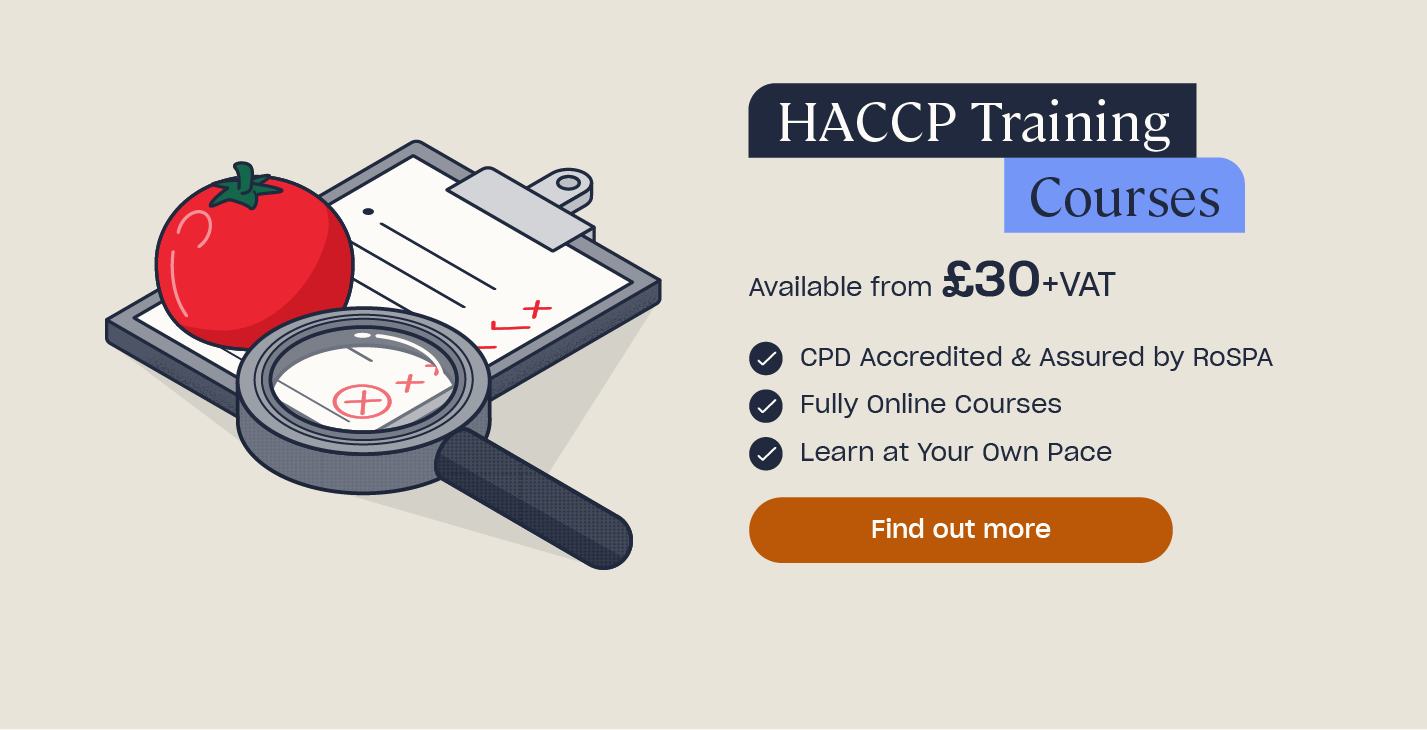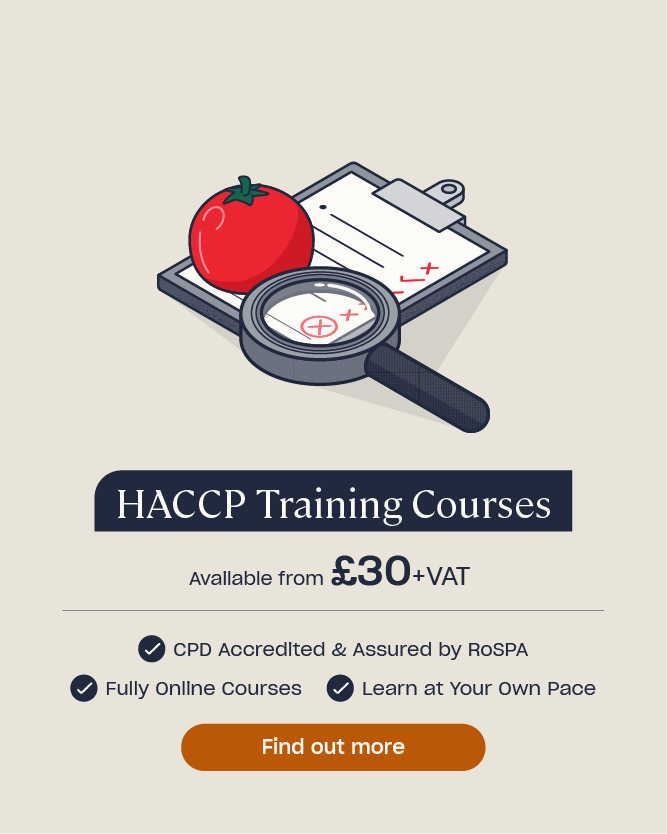What are the 7 Principles of HACCP?
HACCP is an internationally recognised food safety management system that stands for Hazard Analysis and Critical Control Point. A HACCP system is based on seven key principles, which aim to assess and control the risks to food safety.
In order for any food business to be successful, there needs to be an effective food safety management system in place. A food safety management system enables you to comply with food hygiene law and ensure that the food you handle is safe for your consumers to eat.
In this article, we will look at each of the seven HACCP principles and why they are essential to a food business. We’ll also look at how to implement a HACCP system in your workplace.
- What is HACCP?
- Why are the HACCP Principles Important?
- What are the 7 Principles of HACCP?
- How to Implement the Principles of HACCP
What is HACCP?
As we’ve explained, HACCP stands for Hazard Analysis and Critical Control Point and is a food safety management system that helps businesses identify, evaluate and control the hazards that pose a significant risk to food safety.
HACCP is a system based on seven key principles. These are:
- Conduct a hazard analysis.
- Determine the critical control points (CCPs).
- Establish critical limits.
- Monitor the CCPs.
- Establish corrective actions if a CCP is out of control.
- Establish verification procedures.
- Keep accurate documentation and records of each stage.
Food safety management is a fundamental requirement for all food businesses in order to ensure that the food produced is safe for consumption. The HACCP principles involve taking a preventative approach by looking at what could go wrong at each stage in the food production process and implementing controls to prevent problems from occurring.

Why are the HACCP Principles Important?
Following safe food hygiene procedures is not simply good practice, but something that you must do by law. One of the laws that you must follow is the Food Safety Act 1990.
The Food Safety Act 1990 is a piece of legislation concerned with food standards. This Act makes it an offence to:
- Produce food that’s dangerous to health.
- Produce food which fails to comply with food safety requirements.
- Produce food that is not of the nature, substance, or quality expected by the consumer.
Article 5 of Regulation (EC) No 852/2004 – which has been retained within GB law – states that: ‘Food business operators shall put in place, implement and maintain a permanent procedure based on the Codex HACCP principles.’
Therefore, having a food safety management system in place which is based on the HACCP principles is a legal requirement. Alongside ensuring your compliance with food safety law, successfully implementing the HACCP principles will help to:
- Avoid costly product recalls.
- Protect the reputation of the business.
- Increase customer and consumer confidence.
- Reduce the likelihood of contamination.
- Establish a good traceability system.

While it’s usually the food business owner’s duty to implement the HACCP system, all employees are responsible for maintaining it. Failing to process and store food in a safe way can lead to a number of dangerous consequences, including fines, loss of business, and serious health risks for consumers.
Looking to learn more?
For everything you need to implement effective food safety management systems, check out our range of HACCP courses, including Level 2 HACCP for Manufacturing for employees and Level 3 HACCP for Manufacturing for food business owners and managers in the food manufacturing industry.
Food Safety Hazards
Without a thorough understanding of food safety hazards, it’s difficult to establish effective controls and create a successful HACCP system.
Food safety hazards can be placed into four categories:
- Physical hazards – This refers to physical items in food that should not be there. Examples include: jewellery, hair, feathers, or bones. Physical contamination can be caused by people, packaging, products, pests, the premises or machinery (the plant).
- Chemical hazards – Chemical hazards can contaminate food at any stage in the manufacturing process. For example, this could include residue of chemicals left in equipment after cleaning or the misuse of fertilisers or pesticides on vegetables.
- Allergenic hazards – As the smallest quantity of an allergen has the potential to cause such life-threatening consequences, it’s essential that your food business has a system in place to prevent allergenic ingredients from contaminating foods that are stated to be allergen-free. You can find a free poster to download on the 14 named food allergens in our article, here.
- Microbial contamination – Microbial contamination of food is the most common reason behind outbreaks of food poisoning and food spoilage. It can arise from a number of different causes, including incorrect food handling, and not cooking a product to the correct high temperature. You can learn more about food poisoning in our article, ‘What are the Different Kinds of Food Poisoning?’

Need to implement food safety controls?
For more information on food safety control, check out our range of food hygiene and safety courses, including Level 2 Food Hygiene and Safety for Manufacturing and Level 3 Food Hygiene and Safety for Manufacturing.
What are the 7 Principles of HACCP?
As we’ve established, a HACCP system is based on 7 key principles, and we’ll look into each of these in more detail below.
Principle 1 – Conduct a Hazard Analysis
Principle 1 of HACCP involves conducting a hazard analysis. Similar to a risk assessment, this involves considering all of the procedures and processes within a business that could pose a risk to food products, and therefore cause harm to the consumer. This includes looking closely at the physical, chemical, allergenic and microbial hazards.
Once all of the hazards have been identified and listed, they need to be graded according to how likely they are to occur and the severity of the consequences if they did occur.
Principle 2 – Determine Critical Control Points
Principle 2 of HACCP involves determining the critical control points in the food handling processes. A critical control point (CCP) is the last step where you can intervene to eliminate or reduce a hazard to an acceptable limit.
Unlike Control Points (CPs) – which is any step in the flow of food where a physical, chemical or microbial hazard can be controlled – at a CCP, a loss of control would lead to an unacceptable level of risk if an appropriate control is not implemented to eliminate or reduce it as quickly as possible.
Examples of critical control points could include:
- A point where the temperature reached is critical to the safety of the food, such as pasteurisation.
- A point where if the cooling time of a food is too long, pathogenic bacteria are likely to develop.
- A stage where there is the risk of allergens contaminating food.
To help you decide whether a hazard control point is a critical point or not, check out our article: ‘What is a HACCP Decision Tree?’

Principle 3 – Establish Critical Limits
Principle 3 of HACCP involves establishing critical limits. A critical limit is the maximum or minimum value for the control measure at a CCP in order to prevent, eliminate or reduce the hazard to an acceptable level.
To establish critical limits, there needs to be a criteria that determines when a product changes from being safe to unsafe. This criteria could be physical, chemical or procedural including:
- pH values.
- Salt content.
- Sugar content.
- Temperatures.
Principle 4 – Establish Monitoring Procedures
Principle 4 of HACCP states that the food safety system must have a way of determining whether the CCPs and critical limits are under control. This can be achieved through consistent and continual monitoring.
CCPs should be monitored at all times in order to efficiently detect any loss of control, identify any deviations and ensure that corrective actions are carried out where necessary.
Principle 5 – Establish Corrective Actions
Principle 5 of HACCP involves establishing corrective actions, which is any action that must be taken when the results of monitoring a CCP indicate that a critical limit has been breached.
The aim of corrective action is to:
- Make the product safe.
- Prevent recurrence of the problem.
- Maintain a chain of documentation for audit purposes.
There are 3 levels of corrective action that need to be put in place:
- Immediate action to regain control of the process.
- Short term action to identify and deal with the affected product by placing it under control.
- Long term action to investigate the cause and prevent it happening again.

Principle 6 – Establish Verification Procedures
Principle 6 of HACCP involves establishing verification procedures. This includes regularly reviewing the HACCP system to ensure that the food safety management system is working effectively. This can be confirmed through internal audits, validation and verification procedures.
Validation is the process of collecting evidence to show that the HACCP plan is effective, particularly at the points of critical control and critical limits, in order to prove that the HACCP system will effectively control the hazards.
Verification and internal auditing take an overview of the whole HACCP system rather than individual activities. Verification looks to check that each element of the HACCP system is working correctly, in accordance with the HACCP plan and to ensure that the system is up-to-date.
Principle 7 – Establish Documentation
Principle 7 of HACCP requires accurate records to be kept for each stage of the food safety system. This documentation should verify that the controls in place are working as planned.
Types of documentation that support a HACCP plan include:
- Details of the hazard analysis.
- CCP determination.
- Training records.
- Procedures, such as corrective action procedures, glass breakage procedures and standard operating procedures.
- Cleaning schedules.
- Pest control reports.
- Supplier documentation, such as lists, specifications and audit records.
- Records, for example CCP monitoring including deviations and corrective actions, modifications to the HACCP plan, visual inspection reports and daily checks such as temperature checks.
Documentation is also essential for a due diligence defence should it be needed. For this reason, it’s essential that information, documentation and resources are maintained and kept up-to-date. For more information on this, check out our article: What is Due Diligence in Food Safety and How Can I Evidence it?

How to Implement the HACCP Principles
Before a HACCP management system can be implemented in your business, there are mandatory food safety control measures that must be in place. These essential procedures are known as ‘prerequisite procedures’ and detail the basic conditions that are needed in order to produce safe food. Without having these prerequisites in place, the HACCP system will not be effective.
Examples of prerequisites include, but are not limited to:
- Ensuring only approved suppliers are used. You can find more information on this in our article ‘How to Choose a Reputable Supplier’.
- Implementing pest control procedures. To test your knowledge on these, check out or Pest Control Quiz.
- Following personal hygiene procedures. You can find a free poster to download, along with advice and guidance on handwashing, here.
- Having a stock rotation system (First-In-First-Out) in place. For more information, check out our article ‘Using a FIFO Food Storage System’.
The HACCP plan must be reviewed if there are any changes to the formulation, process or procedures to ensure it is up-to-date and still fit for purpose.
All food business operators have a legal responsibility to ensure that:
- Food handlers are supervised and instructed and/or trained in food hygiene matters that are commensurate with their work activity.
- Those responsible for the development and maintenance of the HACCP procedures have received adequate training in the application of the 7 HACCP principles.
A HACCP system can be implemented ‘in one go’ which can be the faster approach, or in stages by department to make the task more manageable.
Back to TopWe hope you’ve found this article on the 7 Principles of HACCP useful and informative. If you have any further questions, or wish to find out more information on the topics covered in this article, please don’t hesitate to get in touch with us at High Speed Training!
Further Resources
- Level 2 HACCP for Manufacturing
- Level 3 HACCP for Manufacturing
- Food Hygiene Courses
- 28 of your HACCP Questions Answered
- 5 Key HACCP Considerations for the Bakery Industry
- HACCP Quiz
- Food Allergen Risk Assessment & Checklist
- What are the Different Kinds of Food Poisoning?
- Food Product Recall Procedure Template – Free Download
- What is ISO 22000 – Food Safety Management?










